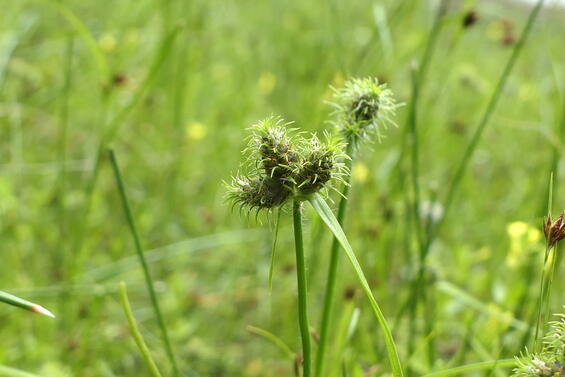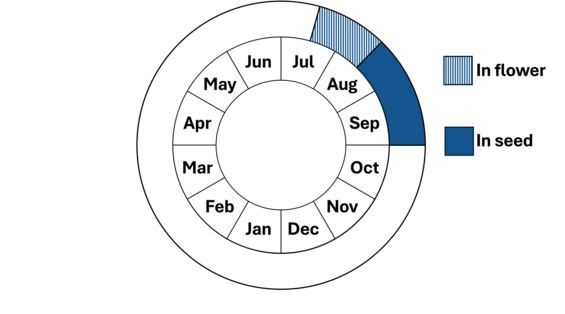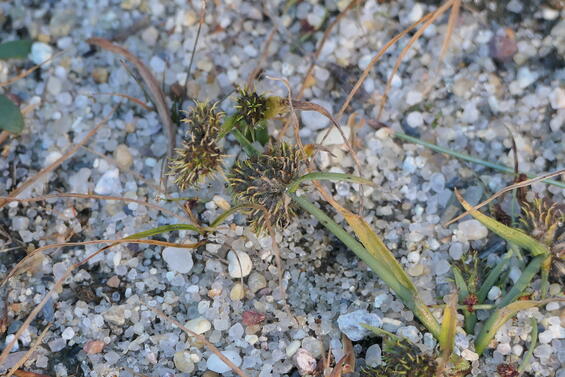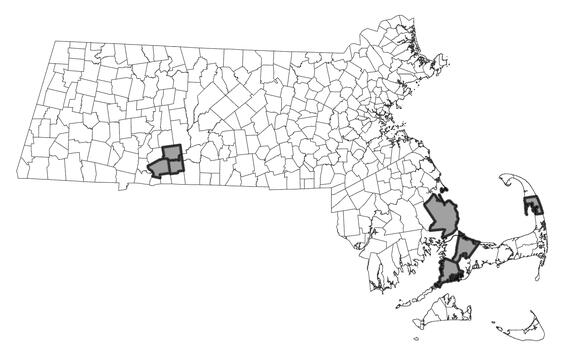- Scientific name: Fuirena pumila (Torr.) Spreng.
Species of Greatest Conservation Need (MA State Wildlife Action Plan)
Description

Annual or dwarf umbrella-sedge (Fuirena pumila) is an annual species in the sedge family, Cyperaceae. It is typically found on coastal plain pond shores. Annual umbrella-sedge is a tufted plant, with many smooth stems arising from the base. It grows 5-45 cm (2 -17.5 in) high. Its leaves are 5-2 cm (2-4.75 in) long and 3-5 mm (<0.2 in) wide, and hairy or scabrous along their margins. The spikelets are in 1 to 3 terminal clusters and are 7 -15 mm (0.25-0.6 in) tall. The compact clusters consist of spirally arranged scales; each scale has a small, recurved awn at its tip, making the flowering cluster look hairy or bristly. Behind each scale is a perfect flower with 3 stamens and a 3 parted style. Surrounding the floret, annual umbrella sedge has 2 types of bristles which are equivalent to petals and sepals and has 3 of each. The mature achenes (seeds) are sharply 3-angled and are on short stalks. Although annual umbrella-sedge is in the sedge family, it is distinctively different from other sedges and is the only species in this genus in Massachusetts; it is unlikely to be confused with any other species once it starts to flower.
Life cycle and behavior

Annual umbrella-sedge grows on wet sandy soils on the shores of coastal plain ponds. It will sprout once the seed is exposed by lower pond water levels in mid-summer, producing flowers from mid-July to mid-August. It is wind pollinated like most sedges. Mature achenes can be found from mid-August through September. It will drop most of its seeds near the parent plant, but it is likely that some seed will be spread through wave action on the pond shore when the water levels rise again.
Population status

Annual umbrella-sedge is listed as a species of greatest conservation need and maintained on the plant watch list. There are 16 occurrences in the state verified since 1999 found in Barnstable, Hampden and Plymouth Counties. There are 28 mappable occurrences which have not been observed within the past 25 years. It is not known from any of the coastal islands, historically or within the past 25 years.
Distribution and abundance
Massachusetts represents the northernmost extent of annual umbrella-sedge along the Atlantic coastal plain. It is known from Massachusetts south to Florida and west to Texas. There are disjunct populations in Illinois, Indiana, Michigan, and Wisconsin. Historically it was known in the Canadian province Ontario but is now presumed extirpated there. It also occurred previously in Arkansas and is thought to be possibly extirpated there. It is considered critically imperiled in Rhode Island and Wisconsin; imperiled in Indiana, Maryland, Michigan and New York; and vulnerable in Massachusetts and Mississippi.

Distribution in Massachusetts. 1999-2024. Based on records in the Natural Heritage Database.
Habitat
Annual umbrella-sedge occurs on sunny, wet, peaty, sandy shores or in boggy areas. In Massachusetts it occurs around both the coastal plain ponds in Barnstable and Plymouth Counties and the inland variant of coastal plain ponds in Hampden County. Associated species might include tall beaksedge (Rhynchospora macrostachya), brownish beaksedge (R. capitellata), Canada rush (Juncus canadensis), other rushes (Juncus spp.), bulrushes (Schoenoplectus spp.), black fruited spikesedge (Eleocharis melanocarpa), beggar-ticks (Bidens sp.), dwarf St. John’s-wort (Hypericum mutilum), lesser St. John’s-wort (H. canadense), and lance-leaved violet (Viola lanceolata).
Healthy habitats are vital for supporting native wildlife and plants. Explore habitats and learn about conservation and restoration in Massachusetts.
Threats
The primary threats to annual umbrella-sedge include trampling and raking beaches by people enjoying the pond but unaware of the presence of this small, rare sedge. Invasive plants, such as common reed (Phragmites australis) and gray willow (Salix cinerea), could shade this species that requires sunny locations which will prevent it from growing. Climate change is a major threat to all coastal plain pond species. Invasive plants, such as common reed (Phragmites australis) and gray willow (Salix cinerea), could shade this species that requires sunny locations and prevent it from growing. Climate change also brings more erratic rainfall, with more years of higher water levels when this species will not be able to germinate as its seed will remain underwater (Staudinger et. al, 2024).
Conservation
As annual umbrella-sedge is not listed species under the MESA, but maintained only on the plant watch list, MassWildlife’s Natural Heritage and Endangered Species Program (NHESP) does not always receive records of observations or the size of those populations observed. This species is under surveyed and under reported. In addition, it does not occur at all its known locations each year, as it will not germinate when water levels have flooded the sandy shore to the shrublines. NHESP knows of many historical populations that have not been observed recently and these need to be revisited in a year when pond water levels are low.
One of the primary threats to annual umbrella-sedge are invasive species which shade exposed shorelines preventing this and other sun loving coastal plain pond shoreline species from growing and reproducing. It is important that invasive species be managed and reduced to the maximum extent possible on these shores. Management could also provide permanent protection of a section of a pondshore for the rare coastal plain pond plants, including annual umbrella-sedge, that will not be trampled through human recreational activities. All active management of rare plant populations (including invasive species removal) is subject to review under the Massachusetts Endangered Species Act (MESA) and should be planned in close consultation with NHESP.
The ecological needs of annual umbrella-sedge are not fully understood. One aspect of research needing study is how many years seed from annual umbrella sedge will survive in a flooded environment. Other research could include more intensive surveys for this species in coastal plain ponds.
References
Fernald, M. L. 1950. Gray’s Manual of Botany, Eighth (Centennial) Edition—Illustrated. American Book Company, New York.
Gleason, Henry A., and Arthur Cronquist. Manual of Vascular Plants of Northeastern United States
Adjacent Canada, Second Edition. Bronx, NY: The New York Botanical Garden, 1991.
Haines, A. 2011. Flora Novae Angliae – a Manual for the Identification of Native and Naturalized Higher Vascular Plants of New England. New England Wildflower Society, Yale Univ. Press, New Haven, CT.
MICHIGAN FLORA ONLINE. A. A. Reznicek, E. G. Voss, & B. S. Walters. February 2011. University of Michigan. Web. Accessed March, 27, 2025 https://lsa-miflora-p.lsait.lsa.umich.edu/#/record/1131
Native Plant Trust. 2014. NORM Phenology Information.
NatureServe. 2025. NatureServe Network Biodiversity Location Data accessed through NatureServe Explorer [web application]. NatureServe, Arlington, Virginia. Available https://explorer.natureserve.org/. Accessed: 3/27/2025.
POWO (2025). "Plants of the World Online. Facilitated by the Royal Botanic Gardens, Kew. Published on the Internet; https://powo.science.kew.org/ Accessed: 3/27/2025
Staudinger, M.D., A.V. Karmalkar, K. Terwilliger, K. Burgio, A. Lubeck, H. Higgins, T. Rice, T.L. Morelli, A. D'Amato. 2024. A regional synthesis of climate data to inform the 2025 State Wildlife Action Plans in the Northeast U.S. DOI Northeast Climate Adaptation Science Center Cooperator Report. 406 p. https://doi.org/10.21429/t352-9q86
Contact
| Date published: | April 29, 2025 |
|---|